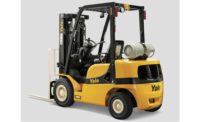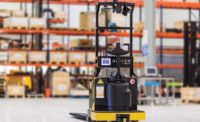To meet rising demand for fast delivery, snack and bakery warehouse operations have little room for error. Thus, many look to technological advances, including automation, to minimize the risk of unexpected delays, and to find new ways to streamline inventory management.
Supply-chain advancements
The latest innovations in pallet trucks and forklifts include narrow-aisle and high-reach capabilities. “With the high cost of real estate, warehouse operators are looking for greater storage density. Reducing aisle width and raising storage increases the total number of bin locations without increasing real estate,” says Alan Dotts, special products sales manager, Toyota Material Handling, Columbus, IN. To that end, Toyota has unveiled three order pickers featuring Lift Logic Speed and Height Control to facilitate picking. The line includes Toyota’s first model in the class to offer a 36-volt option with a maximum reach height of 390 inches.
Yale Materials Handling Corp., Greenville, NC, has introduced an end rider pallet truck series, which is designed to help operations boost labor efficiency and increase throughput in order picking, unloading and other warehouse tasks. The Yale MPE060-080VH end riders address the labor challenges and cost pressures facing supply chains, according to Jim Hess, director, warehouse business development.
“The pallet trucks’ Precision Pick feature enables precise, bi-directional control of speed and coast functions at the press of a button, allowing operators to easily navigate between pick locations. Smart Cruise Control allows them to set truck speed and relax the throttle over long hauls. Also, an optional extended operator platform offers 30 percent more usable floor space than previous models,” Hess notes.
The new Yale robotic reach truck brings infrastructure-free navigation and autonomous operation to lift trucks. “The advantage of ‘roboticizing’ the reach truck is it can deposit and retrieve pallet loads from locations up to 30 feet high and reach into double-deep storage. Its autonomous high-lifting capability makes it ideal for distribution centers facing a shrinking labor pool and the pressure to maximize vertical storage space to accommodate inventory growth driven by e-commerce. Also, operators can switch the truck to manual mode at the touch of a button to handle excess volume or other unexpected demands,” Hess adds.
Forklift connectivity
Increased forklift connectivity improves efficiency and safety, according to Jim Gaskell, director of global technology business development, Crown Equipment Corp., New Bremen, OH. “Today, critical information is readily available via forklift fleet and operator management systems that give managers the opportunity to create and maintain a safety culture.” This includes safety-based applications that manage equipment access and operator certification and streamline pre-shift inspections.
Crown’s QuickPick Remote order picking system gives operators the ability to control the vehicle from the aisle, and to maintain a consistent pace during the picking process. Operators simply press a button on wearable technology to advance the forklift to the next pick location, virtually eliminating the need to return to the operator compartment while picking within the aisle. The system operates independently of warehouse networks, which means it is easy to set up and does not consume valuable bandwidth or require costly IT investments.
“Originally only available via a glove, remote control technology now can be used through a transceiver strap or trigger based on the operator’s preference,” Gaskell says.
Many providers today convert forklifts or lift trucks into autonomous guided vehicles (AGVs), making the cost of automation less of a barrier to entry, according to Alec Hicks, group director, solutions design, Ryder System, Inc., Miami. “In addition, providers of autonomous mobile robots (AMRs) offer technologies that can accompany people while they complete picking tasks.”
Driverless vehicles
In the past, autonomous warehouse vehicles were limited to wire guidance or fixed floor plans, according to Dotts. “The latest innovations—such as laser guidance and wideband technology—make autonomous vehicles more flexible. Installations and modifications can be made in a fraction of the time needed with older technologies.”
OTTO Motors, a division of Clearpath Robotics, Kitchener, Ontario, has introduced the OTTO OMEGA self-driving lift truck, which is able to react to changes on the floor in real time and move around obstacles. With artificial intelligence at its core, OTTO OMEGA learns new skills with every software update. The vehicle receives orders, reports on its status and notifies human operators of issues in real-time. It collects data from its surroundings and by learning from human operators while communicating with a centralized control system.
The latest developments in autonomous vehicles include high-stacking capabilities and the ability to work in narrow aisles, according to Baptiste Mauget, vice president of marketing, Baylo, Paris. “Balyo’s latest innovations are based on improving the perception of pallets in racks by using 3D camera sensors. We now can see a load before picking it in a rack at any height. Also, the Safety 360° PL-D system, available on most of Driven by Balyo robots, ensures the safety of both machines and operators.”
Autonomous mobile robots (AMRs)—small wheeled platforms that carry containers or shelves—assist humans with picking and material transport tasks, minimizing heavy lifting and long-distance walking. The robots are at the forefront of a shift toward collaborative automation, notes Joe Lau, director of product marketing, Fetch Robotics, San Jose, CA.
Lau sees steady improvement in collaborative robots. “Improved sensor technology on AMRs, for example, means that robots can safely move at higher speeds. Our robots are safety-certified in Europe.” He notes that the Robotic Industries Association is working on a U.S. standard for collaborative robots.
Automated picking
Advances continue in order picking, as well. High-density automated storage and retrieval systems (AS/RS) and human interface tools can expedite the goods-to-consumer process and reduce the number of times an item needs to be touched.
Voice-directed and radio frequency (RF) picking are mature and reliable technologies, notes Hicks. “Our focus at Ryder is on providing technology that allows people to keep their hands free while performing tasks. We also are introducing technologies that integrate voice, hands-free RF and vision-enabled picking to further improve productivity. AS/RS are effective at automating picking processes and improving cube utilization, but significant physical infrastructure is required for these solutions.”
Order-picking systems fill orders faster, helping keep perishable snack and bakery products fresh. To further improve the process, UNEX Manufacturing Inc., Lakewood, NJ, offers tilted shelving that keeps products at the pick face. Once a product is picked, the SKU behind it flows forward, making it easier to fill orders, according to Brian C. Neuwirth, president.
These systems also reduce physical stress on people while increasing productivity. “Lifting and moving equipment, pallets and boxes in the warehouse can lead to fatigue and injury, especially when workers perform these tasks repeatedly,” Neuwirth adds. “UNEX carton and gravity flow systems help with ergonomics by keeping products off of the floor where workers have to bend and reach, which can increase the risk of injury. Adding ergonomic carton and gravity flow systems to existing pallet racks can further alleviate these injuries.”





